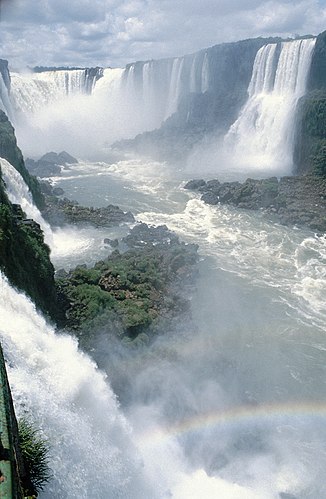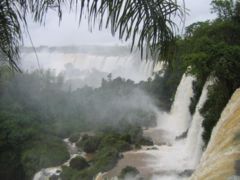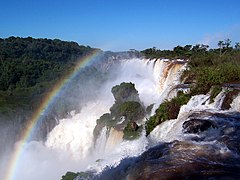Iguazu Falls
| Iguazu Falls | ||
|---|---|---|
|
Garganta del Diablo seen from the Brazilian side |
||
| Coordinates | 25 ° 41 '43 " S , 54 ° 26' 12" W | |
|
|
||
| place | Paraná , Brazil / Misiones , Argentina | |
| width | 2700 m | |
| Falling watercourse | Iguaçu / Iguazú | |
| Estuarine waters | Iguaçu / Iguazú | |
The Iguazú Waterfalls ( Portuguese Cataratas do Iguaçu [ kata'ɾatɐs du igwa'su ], Spanish Cataratas del Iguazú [ kata'ɾatas del iɣwa'su ]) are the waterfalls of the Iguaçu / Iguazú river on the border between the Brazilian state of Paraná and the Argentine province of Misiones .
description
The Iguazú Falls consist of 20 larger and 255 smaller waterfalls over an area of 2.7 kilometers. Some are up to 82 meters, the majority are 64 meters high. The amount of water in the falls varies from 1500 m³ / s to over 7000 m³ / s. The border between Argentina and Brazil runs lengthways through the falls. Since most of the falls are in Argentina, the greater panoramic view is possible from the Brazilian side. The falls are separated from each other by several larger and smaller islands. Of the 2,700 meter extension, no water flows over approximately 900 meters. The main waterfall (or waterfall system) is colloquially called Garganta del Diablo (Spanish) or Garganta do Diabo (Portuguese) or "Devil's Throat" and is a U-shaped, 150 meters wide and 700 meters long canyon. An approx. 600 meter long walkway leads to the fall edge.
Nearby are the cities of Foz do Iguaçu in the Brazilian state of Paraná and Puerto Iguazú in the Argentine province of Misiones and the Itaipú reservoir .
The falls were added to the list of the Seven Wonders of the World in 2011.
Word origin
The name Iguazú has its origin from the guaranic words y for water and guasu for big . The Spanish conquistador Álvar Núñez Cabeza de Vaca was the first European to discover the falls; one on the Argentine side is named after him.
National parks
The national parks on both sides of the falls were in 1984 ( National Park Iguazú , Argentina) and 1986 ( Iguaçu National Park , Brazil) in the World Heritage List of UNESCO added. They protect one of the last remnants of the Atlantic rainforest and represent an important economic factor due to tourism . The national parks are an important retreat for biodiversity in the Iguaçu area. Around 800 different butterfly species live here alone. Poaching by poorer sections of the population is a problem in the national park. Park rangers are supposed to secure the stock. Nevertheless, the giant otter seems to have already been exterminated. The skin of the caimans is particularly popular , which is why they are protected accordingly.
In 1999, the Brazilian part of the park was put on the Red List of World Heritage in Danger because residents reopened a street that was closed when the park was set up. The 17.5 km long road that divides the park into two halves in a north-south direction saves residents a 130 km detour. In 2001, after federal courts enforced the closure, the national park was removed from the red list. The political dispute does not seem to be over.
On the Argentine side, the Tren Ecológico de la Selva runs from the visitor center of the national park to various viewpoints of the waterfalls.
fauna
Behind the waterfalls, the soot swifts live and breed in the rock; the unique protection of the water protects them from all natural enemies. The only danger to the population is when there is a flood during the rainy season . Large populations of South American coatis roam the entire national park , plunder rubbish bins in search of food and sometimes become aggressive and vicious towards tourists.
myth
The myth of the Guaraní explains the waterfalls as the work of the jealous god Mboi or Boi. The evil and vengeful god in the form of a giant snake demanded a virgin every year. Once the chosen one fled downstream with her lover by canoe. (M) Boi noticed this, however, and furiously cut a ravine in the river bed. The girl's soul was trapped in a rock at the foot of the waterfall and forever separated from it, her lover then turned into a tree on the bank of the Devil's Throat, where he kept an eye on this rock.
Illustrations
Movie
- The largest waterfalls on earth - natural wonder Iguazu . Documentation, 45 min., Director: Christian Baumeister, production: NDR , first broadcast: January 8, 2007
- As the setting for a historical event, the waterfalls form the backdrop for the feature film The Mission (1986).
- In Indiana Jones and the Kingdom of the Crystal Skull (2008), the heroes tumble down several cascades of the waterfalls, although the actual topography has been greatly altered and the final fall begins from one of the highest points of the falls.
- In James Bond - Moonraker - Top Secret (1979), the empty boat Bonds and the one chasing him and the walker popping down the waterfalls, where Beißer survives unharmed despite the great height.
literature
- Ernst von Hesse-Wartegg: The Iguazú Falls in the paradise of Argentina. With six illustrations based on original photographs. In: Reclams Universum: Moderne Illustrierte Wochenschrift 27.1 (1911), pp. 426-429.
Web links
Argentina
- Argentine Park Administration website - multilingual website
- Entry on the UNESCO World Heritage Center website ( English and French ).
Brazil
- Website of the Brazilian parking company - multilingual website, but the German translation is sometimes difficult to understand
- Entry on the UNESCO World Heritage Center website ( English and French ).
Individual evidence
- ^ Seven wonders of the natural world . September 21, 2011, ISSN 0307-1235 ( telegraph.co.uk [accessed March 17, 2019]).
- ↑ Status report 1999 of the World Heritage Committee (PDF; 362 kB), p. 7 and status report 2006 (PDF; 1.4 MB), p. 75f (both in English)
- ↑ Reichholf, JH: Breeding and sleeping places behind waterfalls: Evolutionary consideration of the extraordinary behavior of the Brazilian soot swift Cypseloides senex , in: Ornithologischer Anzeiger. Journal of Bavarian and Baden-Württemberg Ornithologists, Volume 43, Issue 1, May 2004, 49–55.
- ↑ coatis in Iguazu National Park , urlaubmachen365.de
- ↑ Myth of Iguazu in Wisegeek (English)













